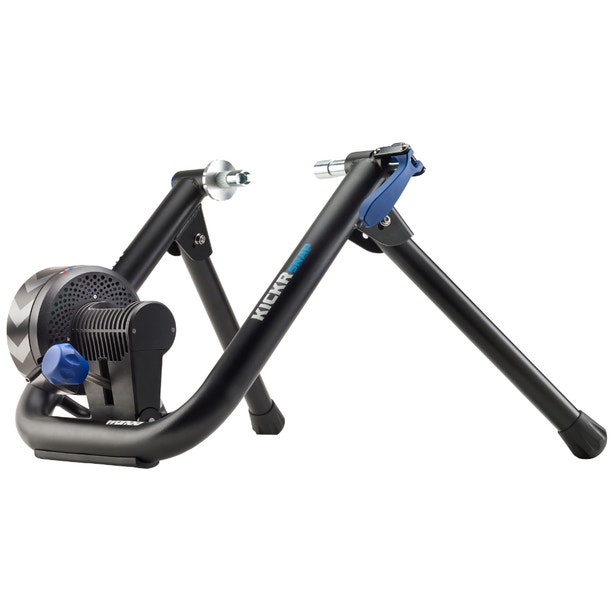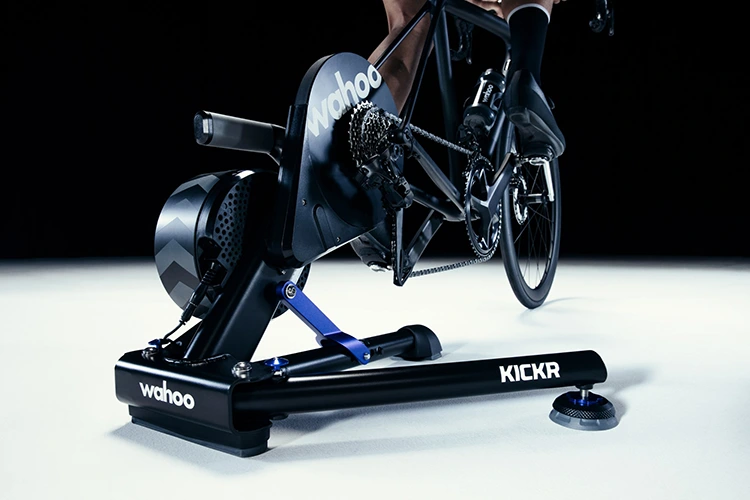A game-changing piece of indoor cycling history, the Wahoo KICKR Climb has been one of the most sought-after pieces of indoor training equipment since 2017.
Using a simple but elegant design, the climbing gradient simulator quickly gained a following of thousands of dedicated users.
The KICKR Climb is still incredibly popular – for those who can afford it AND who have a Wahoo KICKR Smart Trainer – and for good reason.
Wahoo has created an expensive piece of art in the Wahoo KICKR Climb, one that you won’t want to put down, and it is ultimately up to you to decide if it’s worth that cost.
But let’s learn more about the gadget, shall we?
Contents
Climbing and Descending On the Indoor Trainer
The Wahoo KICKR Climb is a smart trainer add-on that raises and lowers the front of your bike, in accordance with the gradient on your favorite indoor training app. It’s a high-functioning piece of technology with a helluva lot of detail behind it, and years of design, testing, and revision to create the ideal indoor climbing machine.
Compatible with only Wahoo KICKR Smart Trainers, the KICKR Climb is limited in its user base, but for those who can afford its $700 price tag, it is well worth it.
Let’s take a closer look at the Wahoo KICKR Climb.
Wahoo KICKR Climb Key Specifications

Price: $700
Maximum Simulated Gradient: +20% / -10%
Compatible Trainers: Wahoo Smart Trainers (KICKR, KICKR CORE, and KICKR SNAP) 2017 Edition and newer
Supported Hubs: QR, 12×100, 15×100, 15×110
Set-up is easy – straight out of the box, all you have to do is mount the appropriate adapter, and your KICKR Climb is ready to connect to your bike.
Once you have the skewer in, you can remove your bike’s front wheel, and pull the KICKR Climb in between the bike’s fork. Simply line up the dropouts with the skewer and tighten it down.
If you’re not sure exactly where the KICKR Climb should sit on the floor, just lift your front wheel up while it’s attached to the KICKR Climb, and as soon as the unit is balanced, gently place it on the floor. This is its optimal position, one that won’t make you feel like you’re tipping back or falling forward.
The KICKR Climb works with standard quick-release hubs, as well as 12×100, 15×100, and 15×110 thru-axle hubs.
When it comes to the wireless pairing process, the Wahoo KICKR Climb does not operate as a smart trainer. Instead of pairing directly to the app, such as Zwift, the KICKR Climb connects to a nearby compatible trainer, such as the Wahoo KICKR.
This means that the KICKR Climb doesn’t take up any Bluetooth space on Zwift, Rouvy, or RGT Cycling. All it needs to do is communicate with the compatible smart trainer, and it will automatically adjust to the proper gradient.
The actual pairing process is as easy as you’d like. You simply hold the KICKR Climb’s remote close to the compatible smart trainer and hold the middle button until they connect. Voilà!
Other Features

Despite its basic-looking design, the Wahoo KICKR Climb is actually an aesthetically pleasing architectural feat. The unit is not flat on the bottom but instead rolls back and forth to provide a little give to the fork and the front of the bike.
Without this simple but often overlooked feature, the KICKR Climb would have a stiff and unforgiving feel – on top of that, it might even damage your bike.
But no need to fear, because the Wahoo KICKR Climb is designed exceptionally well, and uses these slight nuances to create a smooth and realistic ride.
The Wahoo KICKR Climb seamlessly connects with third-party training apps such as Zwift and can simulate gradients of +20% and -10%. Wahoo even includes a small remote control that can be used to raise and lower the KICKR Climb.
There are two different modes in which you can use the KICKR Climb: locked and unlocked. In locked mode, the height of the KICKR Climb is completely operated by the remote control, which gives you the ability to override the simulated gradient of a third-party app. The plus and minus signs will do the trick, nothing fancy here.
In unlocked mode, the KICKR Climb is controlled by a third-party app or compatible head unit such as the Wahoo ELEMNT Bolt. To switch modes, all you need to do is press the center button on the remote control. Double-clicking on the remote control resets the height of the KICKR Climb, returning it to its vertical midpoint.
Wahoo KICKR Climb Considerations
For $700, the Wahoo KICKR Climb doesn’t do a whole lot. Of course, it uses wireless technology to automatically change the height of your fork in accordance with the simulated gradient of a third-party training app. But when you say that in fewer words: it slightly raises and lowers the front of your bike.
That’s the biggest downside of the Wahoo KICKR Climb, the bang for its buck. The unit doesn’t tilt side to side (more than a centimeter or two), and so climbing out of the saddle just doesn’t feel the same as it does outside.
Using a Wahoo KICKR or Wahoo KICKR Snap, you’ll still have a stiff rear end, and so you can’t pull the bike side-to-side as you would up a real-life 15% climb.
Wahoo says that the reason for the KICKR Climb’s eye-boggling price is safety. Each part of the KICKR Climb is designed and built with safety in mind, from the moving slots to the internal parts, to the rounded base.
Wahoo wants the KICKR Climb to be functional, but more importantly, safe. It would be easy to design a cheap add-on that raises and lowers your fork during an indoor training session.
But when you factor in a rider’s weight shifting from in to out of the saddle, how we push and pull on the bars during a sprint, and how our arms crank from side to side while digging deep, the KICKR Climb needs to be as strong and as safe as possible, while adding to the indoor riding experience. Wahoo knocked it out of the park.
Downsides Of KICKR Climb

A big downside of the KICKR Climb is the fact that it is only compatible with Wahoo KICKR Smart Trainers from 2017 or later (check your trainer’s compatibility here), such as the Wahoo KICKR or Wahoo KICKR Snap.
That really limits your options if you’re in the market for a new trainer, and if you already have a trainer you like, you would have to drop $500+ on a new one if you ever wanted to try out the KICKR. Exclusivity is nice sometimes, but it is also very…exclusive.
The first time the Wahoo KICKR Climb moves, it feels weird. But after just a few minutes of riding on the indoor trainer, you’ll completely forget that it’s there. The climbs that we’re riding up on Zwift, Rouvy, or RGT Cycling are not insane – most of the time – and with gradient changes of +/-5 to +/-7%, you hardly notice the KICKR Climb.
On its own, the KICKR Climb is a bit noisy. Standing in a room with no one else around, if you move the KICKR Climb from +10% to -10%, it makes quite the ruckus.
But once you get going on the trainer, with the faint noise of the flywheel and the constant noise of your drivetrain, you can hardly hear the KICKR Climb.
Since the release of the Wahoo KICKR Climb in 2017, Wahoo has fielded complaints about the timing and lag associated with the KICKR Climb.
Wahoo has made a number of updates over the years, and the timing and smoothness of the KICKR Climb is better than ever. But keep in mind that, if you find an older or used model of the KICKR Climb, it might not be as smooth as the latest version.
Other Wahoo Indoor Trainers

We’ve mentioned a few of the Wahoo trainers by name, so let’s take a closer look at the different trainers you could use with the Wahoo KICKR Climb:
- Wahoo KICKR Smart Trainer ($1,200) – Wahoo’s leading product and one of the most popular smart trainers in the world, the Wahoo KICKR is about as good as it gets. Its silent flywheel creates a smooth and realistic ride, while its integrated power measures accurately to +/-1.5%. The only negative is the price tag.
- Wahoo KICKR Snap ($500) – Wahoo’s wheel-on smart trainer, which claims to be the most accurate on the market at +/-3% power accuracy. For less than the price of the Wahoo KICKR Climb, you get a smart trainer that generates 1500w of resistance and a smooth ride that some direct drive trainers struggle to match.
- Wahoo KICKR Bike ($3,500) – Wahoo’s “Ultimate Indoor Training Machine,” made for those with deep pockets and high standards. For those who would rather ride inside than out, the Wahoo KICKR Bike has a KICKR Climb basically integrated into its front end and matches the simulated gradient of a third-party indoor training app.
For other smart trainers, see our reviews of Elite Suto and Tacx Flux smart trainers (but they are not compliable with the KICKR Climb).
Or see the Best Indoor Bike Trainers
Summary
 The Wahoo KICKR Climb moves us one step closer to the ultimate indoor riding experience.
The Wahoo KICKR Climb moves us one step closer to the ultimate indoor riding experience.
With just a bit of side-to-side movement, and a bit more fore-and-aft, you’ve got it: real-life riding on the indoor trainer. But considering the cost, the KICKR Climb doesn’t do a whole lot.
It certainly adds to the indoor training experience, but it still leaves a lot to be desired for the cost of a high-end wheel-on smart trainer.
If $600 sounds good to you, you’re going to love it. There are no complaints regarding the ride feel of the Wahoo KICKR Climb.
It makes every climb better, and every descent a little more fun. The KICKR Climb is a fantastic add-on to a line-up of products fighting for the top spot in the indoor training space.
Wahoo products are clean, capable, and quiet; and the Wahoo KICKR Climb is no exception. Once you try it, you’ll never want to go back.






